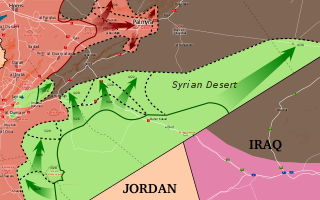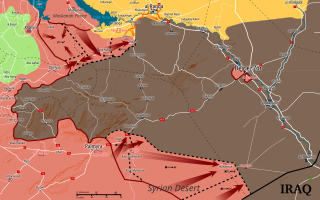The following is a timeline of the Syrian Civil War from August to December 2015. Information about aggregated casualty counts is found at Casualties of the Syrian Civil War.

The 25th Special Mission Forces Division, mostly known by their former name Tiger Forces or Quwwat al-Nimr, is an elite formation of the Syrian Arab Army under the charge of Alawite commander Suheil al-Hassan. It was formed in late 2013 and functions primarily as an offensive unit in the Syrian Civil War. It has been described as a "hot commodity for any government offensive", but their relatively small numbers make it difficult to deploy them to multiple fronts at once.

The Palmyra offensive was a military operation of the Syrian Arab Army, supported by Russian airstrikes, to recapture from the Islamic State the city of Tadmur, which was strategically important for both forces due to its position in central Syria. The city was fully recaptured on 27 March.

The Wadi Barada offensive (2016–2017) was a military operation against rebel-held villages in the Barada River valley by the Syrian Army and allied forces, including pro-government militias and Lebanese Hezbollah between December 2016 and January 2017. The Barada River valley includes the village of Ain al-Fijah which holds a water spring that provides drinking water to towns throughout the Rif Dimashq Governorate.
The following is a timeline of the Syrian Civil War from January to April 2017. Information about aggregated casualty counts is found at Casualties of the Syrian Civil War.

The Deir ez-Zor offensive was a military operation launched by the Islamic State of Iraq and the Levant (ISIL) against the Syrian Armed Forces, to capture the city of Deir ez-Zor, on 14 January 2017. The offensive came amid the group losing large amounts of territory in the Raqqa offensive as well as the Turkish military intervention in Syria, while Iraqi forces were advancing in its Iraq headquarters in Mosul. It ended with the city being split into two parts.

The Idlib Governorate clashes , were military confrontations between Syrian rebel factions led by Ahrar al-Sham and their allies on one side and the al-Qaeda-aligned Jabhat Fatah al-Sham and their allies on the other. After 7 February, the clashes also included Jund al-Aqsa as a third belligerent, which had re-branded itself as Liwa al-Aqsa and was attacking the other combatants. The battles were fought in the Idlib Governorate and the western countryside of the Aleppo Governorate.

The Palmyra offensive in 2017 was launched by the Syrian Arab Army against the armed forces of the Islamic State of Iraq and the Levant (ISIL) in the Eastern Homs Governorate in January 2017, with the goal of recapturing Palmyra and its surrounding countryside. ISIL forces had retaken the city of Palmyra in a sudden offensive from 8 to 11 December, after previously being expelled from it by Syrian government and Russian forces in March 2016. On 2 March 2017, the Syrian Army alongside Russian reinforcement, succeeded again in recapturing the beleaguered city of Palmyra.

The Daraa offensive , code named as the battle of "Death Rather than Humiliation" by the rebels, was a military operation launched by Syrian rebels against positions of the Syrian Arab Army in the Manshiyah District of Daraa city, in southern Syria, during the Syrian Civil War.

The East Aleppo offensive (2017), also referred to as the Dayr Hafir offensive, was an operation launched by the Syrian Army to prevent Turkish-backed rebel forces from advancing deeper into Syria, and also to ultimately capture the ISIL stronghold of Dayr Hafir. Another aim of the operation was to gain control of the water source for Aleppo city, at the Khafsa Water Treatment Plant, in addition to capturing the Jirah Military Airbase. At the same time, the Turkish-backed rebel groups turned towards the east and started launching attacks against the Syrian Democratic Forces, west of Manbij.

The Eastern Homs offensive in 2017 was a military operation of the Syrian Arab Army and its allies in Eastern part of Homs Governorate against Islamic State of Iraq and the Levant forces during the Syrian Civil War.

The Hama offensive was a military offensive launched by Syrian rebel groups led by Hay'at Tahrir al-Sham (HTS) north of the city of Hama, as part of the Syrian Civil War. The offensive began on 21 March 2017, and the rebels aimed to recapture areas recaptured by the Syrian Armed Forces in the 2016 Hama offensive, as well as pushing into Hama city. The offensive was coordinated with rebel forces in Damascus' eastern suburbs, who launched their own operation in March 2017.

The Syrian Desert campaign was a large-scale military operation of the Syrian Army that initially started along the highway from Damascus to the border with Iraq against rebel forces during the Syrian Civil War. Its first intended goal was to capture both the highway and the al-Tanf border crossing, thus securing the Damascus countryside from a potential rebel attack. Later, multiple other fronts were opened as part of the operation throughout the desert, as well as operation "Grand Dawn" against ISIL with the aim of reopening the Damascus-Palmyra highway and preparing for an offensive towards Deir ez-Zor.

The Maskanah Plains offensive was an operation by the Syrian Army against the remaining Islamic State of Iraq and the Levant (ISIL) strongholds in the eastern countryside of the Aleppo Province, with the goal of recapturing the Maskanah Plains from ISIL and advancing into the Raqqa Governorate.
The Eastern Hama offensive (2017) was a military operation conducted by the Syrian Army against Islamic State of Iraq and the Levant (ISIL) with the goal to secure the Ithriyah-Sheikh Hilal road, the government supply line towards Aleppo, and advance towards Wadi Auzain.

The 2017 Southern Raqqa offensive was an operation by the Syrian Army against Islamic State of Iraq and the Levant (ISIL) in the southwestern countryside of the Raqqa Province.

The Central Syria campaign, known as "Operation Khuzam", or "Lavender", was a large-scale military operation of the Syrian Army (SAA) against the Islamic State of Iraq and the Levant (ISIL) during the Syrian Civil War. Its goal was to capture the strategic oil town of Al-Sukhnah, and besiege and capture 11,000 square kilometers of ISIL territory in central Syria, after which the Syrian Army would advance towards Deir ez-Zor, and lift the three-year ISIL siege of the government's enclave in the city. Afterwards, the Syrian Army advanced towards the Islamic State's then-capital of Mayadin.
The 2017 Euphrates Crossing offensive was a military offensive launched by the Syrian Arab Army against members of the Islamic State of Iraq and the Levant (ISIL) in the Deir ez-Zor Governorate, following the breaking of the three-year siege of the city of Deir ez-Zor. The Euphrates Crossing offensive, conducted by government troops, was done with the aim of denying US-backed Syrian Democratic Forces and the US itself leverage over the Syrian government.

The Hama offensive , code-named Oh Servants of God, Be Steadfast, was a military offensive launched by rebel groups led by Hayat Tahrir al-Sham (HTS) north of the city Hama, as part of the Syrian Civil War.

The Northwestern Syria campaign was a large-scale military operation that initially started with an offensive conducted by ISIL forces on areas controlled by Tahrir al-Sham (HTS) in the northern Hama Governorate. Subsequently, the Syrian Armed Forces launched their own offensive against HTS and other rebel groups in the area. The campaign took place at the intersection of the provinces of Hama, Idlib and Aleppo.















